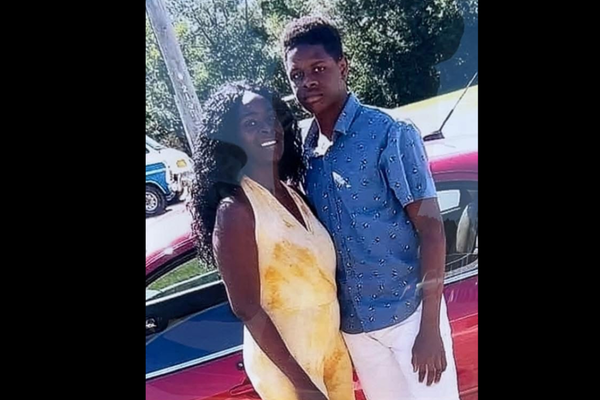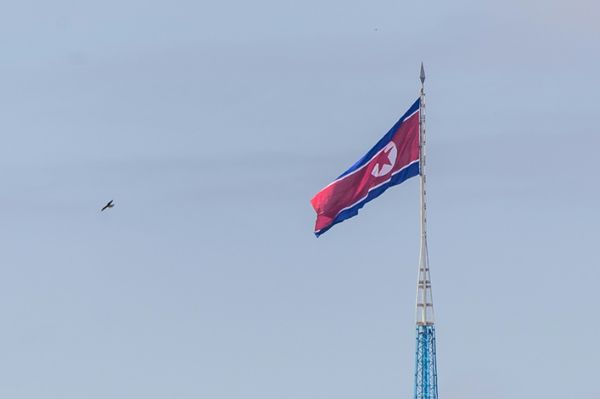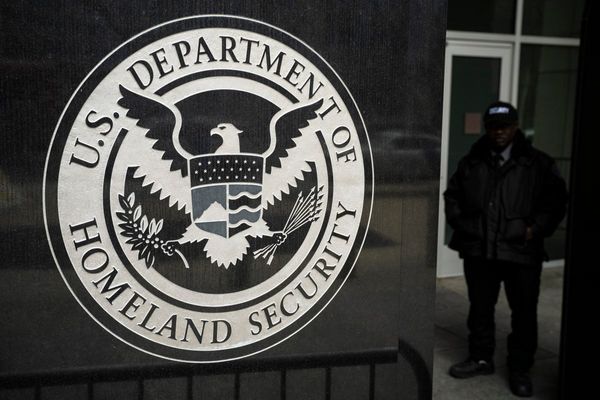From a doctor stranded in Ciudad Juárez to a shelter closed after an outbreak, COVID-19 is hitting hard along the Texas-Mexico border.

By Anna-Catherine Brigida, Acacia Coronado, and Emily Kinskey
June 30, 2020
Leer en español.
This is Part 1 of COVID-19 in the Immigration Pipeline—a series supported by the Pulitzer Center on Crisis Reporting, published by the Texas Observer in collaboration with the Border Center for Journalists and Bloggers.
When news of the pandemic arrived, D.T. found herself locked in a cell on the U.S. side of the Paso del Norte bridge more than 1,700 miles from home, pregnant and desperate.
The 26-year-old had fled Havana, Cuba in July 2019 to seek asylum after being labeled a dissident and beaten by police. Inside the cell, she began suffering abdominal pains. Perhaps they came from injuries suffered in the most violent of two attacks she’d endured during long months waiting in Ciudad Juárez for her asylum claim to be considered by a U.S. immigration judge.
Two other pregnant women shared her cell in March—one looked like she could give birth any minute. D.T., a physician as well as an asylum-seeker, examined their bulging bellies and worried: “Can you imagine being seven and nine months pregnant, sleeping on the floor and eating only a bag of juice and a bread with burger twice a day?” She hoped by the time her belly grew that big she would be resettled with relatives. Perhaps she’d be able to end her own nightmare by explaining her situation to an asylum officer with the authority to grant her permission to temporarily enter the United States as her case made its way through back-logged immigration courts.
Through an iron door with a small glass window, D.T. could see a big television on the wall. On it appeared U.S. President Donald Trump, whose speeches rarely spelled good news for migrants. D.T. couldn’t hear his words, but managed to read subtitles. Between those and comments from U.S. Customs and Border Protection (CBP) officials, D.T. figured out that Trump planned to close the border because of the spread of COVID-19. “I got very depressed. And I realized that they were going to return me to Juárez…. With the coronavirus situation.”
In March, the U.S., Canada, and Mexico reached a mutual agreement to “limit all nonessential travel” across shared borders due to the pandemic. Those travel restrictions were meant to “protect America from all threats, including threats against the health and safety of our citizens,” according to Acting Secretary of Homeland Security Chad F. Wolf of the Department of Homeland Security. But in myriad ways, the decisions increased the perils faced by migrants caught between countries.
Once asylum-seekers, particularly Cubans, could cross more easily to wait in the United States for their cases to be heard if they presented proof of what is called “credible fear” of persecution. But in 2019 the Trump administration had begun a program U.S. officials call Migrant Protection Protocols (MPP), also known as “Remain in Mexico.” Entering the U.S. has become even more difficult since March 21, when U.S. officials announced it would rapidly expel all border crossers, even asylum seekers, and “no longer detain illegal immigrants in our holding facilities.” Only a handful of about 40,000 would-be asylum-seekers stuck in MPP have been allowed to enter since then.
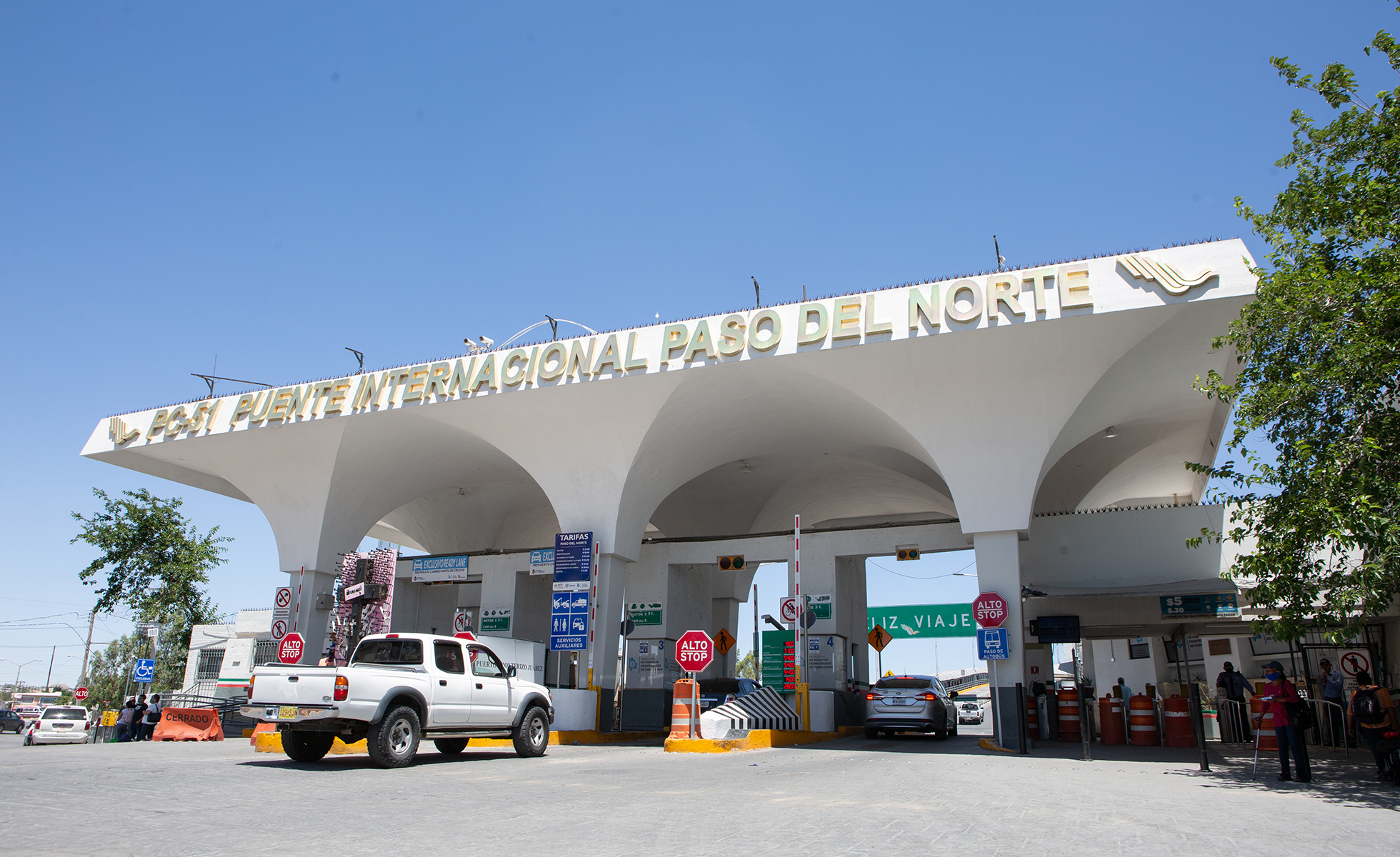
The number of apprehensions of migrants attempting to cross the U.S. border declined in the month after restrictions were imposed, but then increased again. Meanwhile, the pandemic has continued to spread.
In mid-March, when D.T. entered that holding cell, more than 1,000 coronavirus cases had been reported in nearly 40 U.S. states. Texas had confirmed 50 cases and the governor had declared a state-wide public health emergency. By the end of that month, Texas alone already had 3,000 cases. By June, the number of Texas cases had exploded, surpassing more than 125,000.
All along the U.S.-Mexico border, tens of thousands of increasingly desperate asylum-seekers and other migrants remain stalled in the system as reported cases of COVID-19 grow in Mexican shelters, U.S. detention centers, and border states surrounding them. They huddle in cities like Juárez, Nuevo Laredo, and Matamoros, where nonprofits and religious organizations struggle to find ways to help and some residents have turned against them, at times violently, for fear their presence could worsen the spread of the coronavirus and strain already inadequate hospitals.
D.T. understands the health dangers better than most: She graduated with honors from medical school in Cuba. As a doctor, D.T. knows the public health threat will get worse for her and other vulnerable people stuck in the U.S. immigration and deportation pipeline. Many have no homes in which to hunker down.
Nuevo Laredo: Sheltering in Fear
Father Marvin Ajic’s office sits in a sand-colored building guarded by fortified doors on Francisco I. Madero Avenue in Nuevo Laredo, one of Mexico’s most dangerous cities prior to the pandemic. He’s part of a small staff at the Casa del Migrante Nazareth, a place of refuge in another normally busy U.S.-Mexico border crossing 500 miles east of Juárez.
Like many shelter residents, Father Ajic is a recent arrival: He transferred here in February. In Nuevo Laredo, his group receives mostly overnight visitors recently deported from the United States, and migrants forced to wait for asylum hearings. A few came knocking after escaping kidnappers. Others arrived from U.S. detention centers with positive cases of COVID-19.
The Nazareth mission is part of a network of shelters in Mexico and Guatemala operated by the Scalabrinian Missionaries of San Carlos, whose central purpose is to serve migrants and refugees. “We decided to serve the church through serving the migrants,” Father Ajic said.
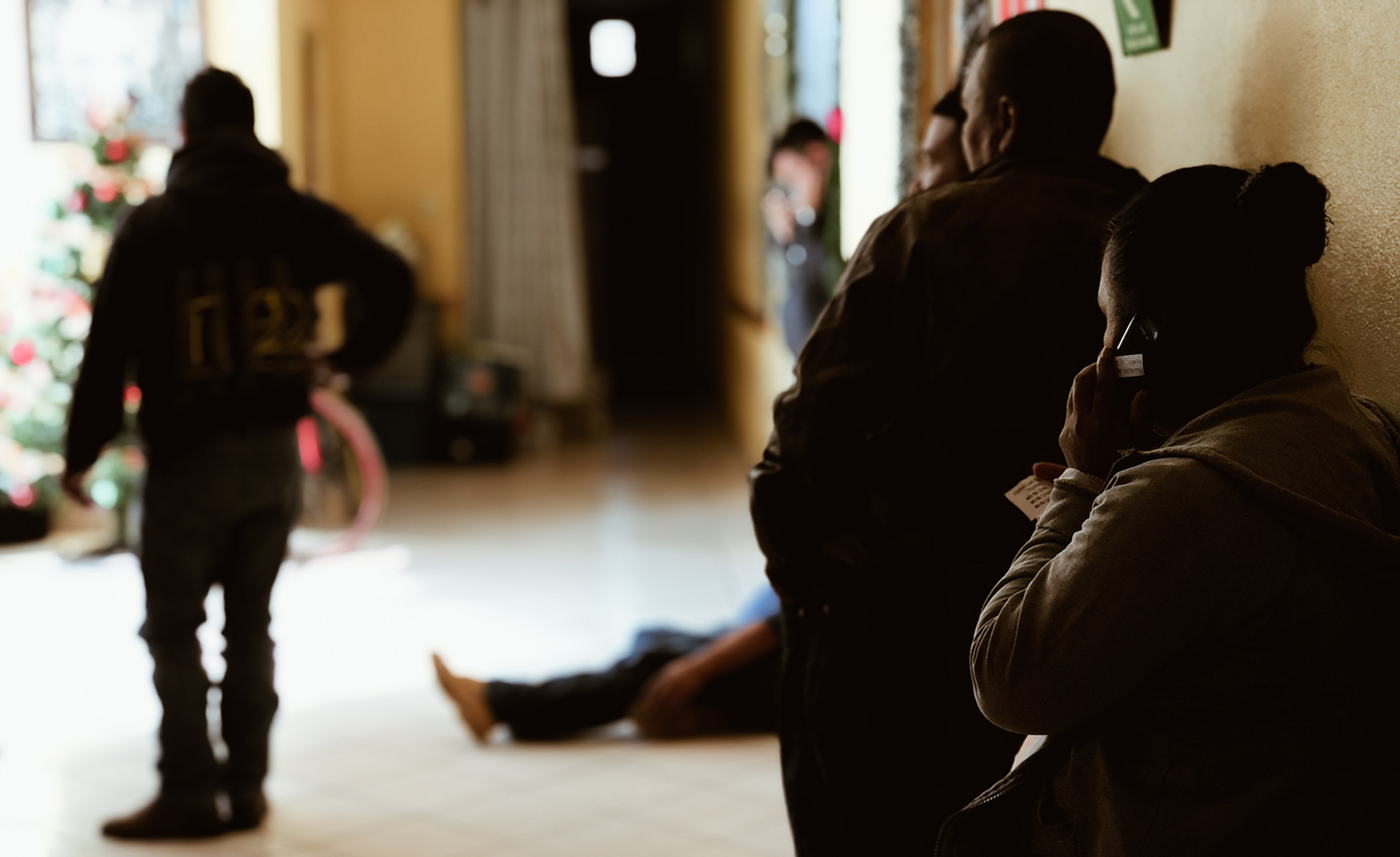
At normal capacity, the shelter holds up to 180 migrants by day and around 120 by night. Usually, residents arrive between the scheduled deportation hours of 8 a.m. and 8 p.m. But after the COVID-19 pandemic began in March, deportation hours were extended first to 10 p.m. and then around the clock. That’s when shelter workers began regularly breaking their own curfew to pick up stranded migrants. By April, they knew some deportees had been exposed to COVID-19, but continued to accept new arrivals anyway. They donned gloves and masks and kept working because they knew from experience that if the shelter’s transport did not arrive in time, organized crime buses would come to kidnap or kill.
Their competitors too continued to work during the pandemic. Kidnappers seeking to extort money from migrants’ family members also adopted precautions: Taking the temperature of victims and using protective gear. “Organized crime hasn’t ceased looking for abandoned Central Americans either,” Ajic said.
Due to policies now in place by U.S. Customs and Border Patrol, many Central Americans and others, even those with legitimate asylum claims, were being returned to the Mexican side. Leaders of other shelters asked Nazareth to shut down operations due to heightened risks, but Ajic said it was a matter of principle to remain open as long as possible. “It is the heart of our mission to stay with those that need us most and in this case more than ever,” Ajic said. “The people outside are our brothers and sisters and we know it is a time bomb, but if we close our doors to them, who is going to help them?”
The shelter often operates under threats from organized crime. According to the U.S. Department of State, the Mexican state of Tamaulipas has long appeared on a Level 4 Do Not Travel advisory for crime and kidnappings. A strict curfew is in place between midnight and 6 a.m. for Nuevo Laredo. The State Department warning says “organized crime activity including gun battles, murder, armed robbery, carjacking, kidnapping, forced disappearances, extortion, and sexual assault” is common. Even the doors to its dorms are fortified with locks to protect against attacks.
To reduce risks of introducing COVID-19 to their community, the priests of Nazareth shelter began calling for U.S. and Mexican immigration authorities to do medical checks on newly deported migrants to ensure they were not carriers of the novel coronavirus. But their calls went unheeded. On April 13, the Diocese of Nuevo Laredo announced that the doors to Nazareth would close to newcomers.
With 57 migrants still inside, that day was initially dedicated to a meeting on the logistics of quarantine. That changed when just before nightfall, one migrant spiked a fever. Then another. After sending both to a local hospital, Ajic said they realized it was too late. The virus had arrived. Now it was a question of who else had been exposed.
On April 14, the first two positive test results came back. Tamaulipas state health authorities began testing more migrants and shelter staff. By April 18, the shelter put out a social media call for five nurses willing to work immediately. By April 20, 15 migrants had tested positive.
At least one migrant with COVID-19 had recently arrived from a Houston detention center already known to have other cases, according to press releases issued by the Mexican state and the diocese. About ten others tested positive after visiting the U.S. port of entry for immigration reasons that week, so it was hard to know who was their patient zero, Ajic said.
Residents who tested negative were soon transported to a retreat house also owned by the diocese. Three staff members went along. Father Ajic, who had already tested negative, and one other staff member volunteered to stay. “If I had been sick, I would hope that someone would stay with me,” Father Ajic said. “And that is what we told them: ‘You are not alone. We are with you. You have never been alone.’”
For Ajic, staying behind is a matter of vocation. When he took his vows, he was clear on the responsibility and the risks of serving this population. When he began working at the shelter, he knew that a fellow priest at a nearby shelter had recently disappeared and was presumed dead. Nazareth shelter too has a long history of volunteers and former residents who were taken away in the night, violently attacked or murdered. Workers are used to taking precautions.
But Ajic said he never expected to face peril from a pandemic. For weeks, he became a nurse, custodian, caretaker, and guardian for the ill. “It has been a learning experience for us to step into the shoes of our nurses today,” Ajic said. “It has given me a lot of strength to see the fragility of the human condition, but also the courage and resilience to keep fighting.”
The three weeks of quarantine in April and May were long and harsh. Though Ajic said most cases were asymptomatic, each ill resident was mostly confined to their room to mitigate the spread. Ajic would help them carefully clean their quarters, change clothes, or simply pass notes under doorways to ask what they needed. “They could have asked for anything, but what most surprised me was that the only thing they asked for was a bag of tea, a spoon of coffee, or some extra sugar,” Ajic said. When he wasn’t tending them, he would go into the city and buy supplies, cook, and distribute meals. Ajic never felt ill himself.
The week of May 18, evacuated residents at the retreat center finally rejoined the COVID-19 survivors at Casa del Migrante Nazareth. With joy and determination, Ajic said he is ready to continue caring for migrants regardless of what comes next.
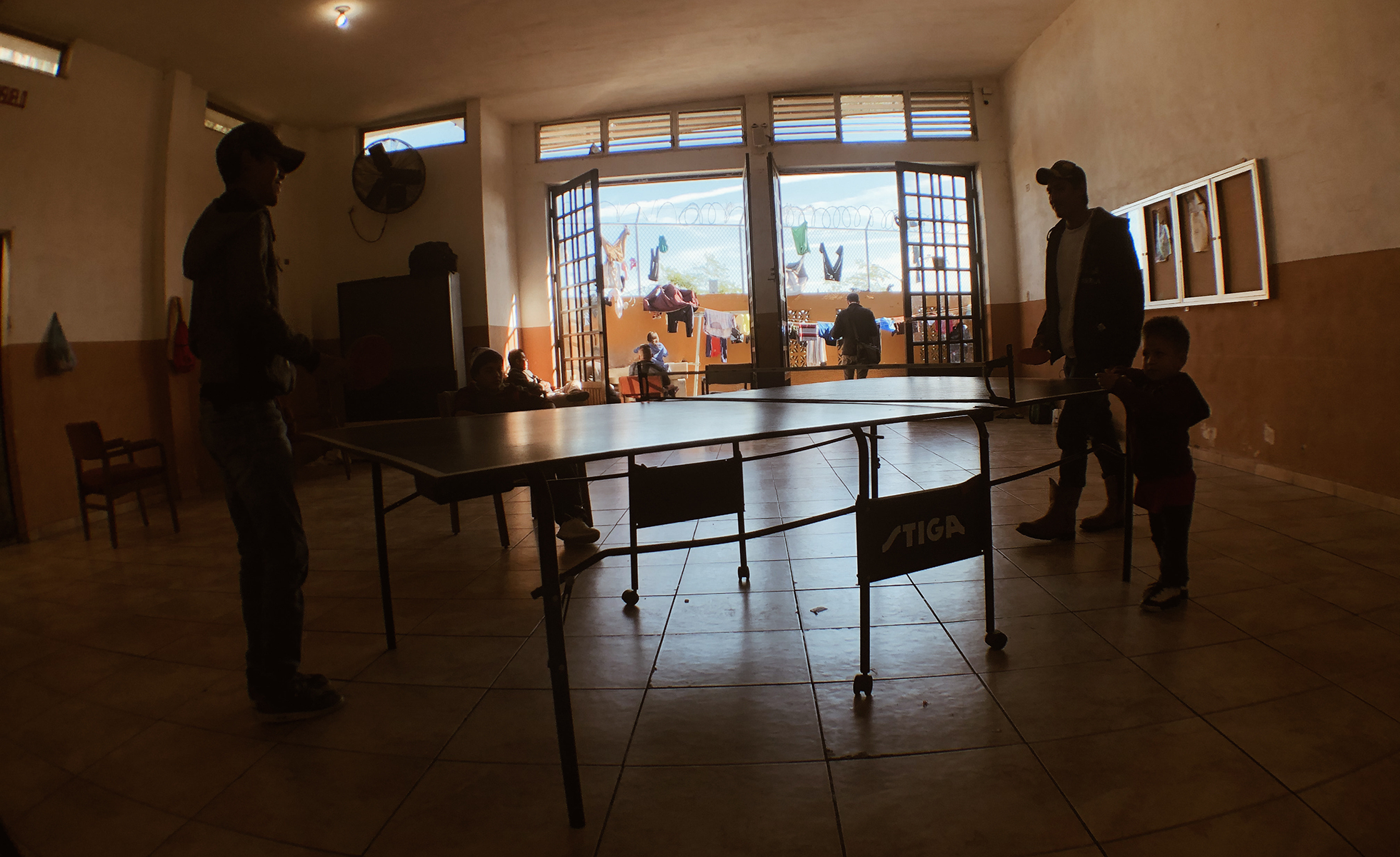
They must adapt as those fortified doors remain shuttered and everyone remains in isolation to prevent another outbreak. With only one TV, children watch cartoons in the morning and adults play movies in the afternoon. Most fear walking outside, a scar they carry from previous attacks and kidnappings. Only 36 migrants remained after others left and the shelter continues to reject new arrivals.
Every day, the shelter gets calls from migrants stranded in Mexico and from others at U.S. detention centers with pending deportation orders. “We try to provide as much help as we can,” Ajic said. For now, all they can do is provide phone numbers of other aid organizations like Instituto Tamaulipas, which do not offer shelter but share information about potentially safe travel hours and bus routes. Ajic worries for migrants who will go unattended.
The priest’s fears are well-founded. Héctor Garcia Mendoza was held at the Elizabeth Detention Center in New Jersey when one of the first major COVID-19 outbreaks in immigration detention began. On May 15, the 30-year-old Mexican national became one of four named plaintiffs in a lawsuit filed against private prison company CoreCivic regarding hazardous conditions for U.S. detainees in the pandemic. The lawsuit called for the detainees’ release. Two other plaintiffs were let go.
On May 18, his attorney, Joelle Lingat, of American Friends Service Committee, received a letter stating Garcia Mendoza would be deported anyway. His attorneys informed immigration authorities they would exhaust all legal remedies, but Garcia Mendoza did not show up for his next meeting: He had already been put on a flight to Laredo. A federal judge quickly ordered a stay of removal, blocking the deportation.
But immigration authorities have claimed that by the time they received the order, the 30-year-old, who had lived for years in the United States, had already been dropped off at the port of entry for Nuevo Laredo. Garcia Mendoza entered Mexico on May 18 between 5:42 a.m. and 10:00 p.m. He has not been seen or heard from since. Members of Congress have called for an investigation into the circumstances of his deportation.
“At this point, the simplest hope that we have is that he is safe,” Lingat said.
Ciudad Juárez: Waiting in Migratory Limbo
D.T.’s journey to the U.S. border to seek asylum began in Havana, where she and her husband faced police violence in 2018 after speaking out against a system that she calls a borderline dictatorship. The last beating in April 2019 landed both in the hospital. So they started making plans to leave.
They flew to Nicaragua in July 2019 and then traveled for 20 days by bus and car to Juárez, resting on the way in cramped and dirty safe houses. “[We were always] scared because we heard many stories of people who had been kidnapped, beaten and even murdered,” said D.T.. In Mexico, they were forced to join a list infamous among migrants—the “metering list” used for people waiting to be processed by CBP. Only a few numbers were called each day. Hers was 17,344.
Even before the pandemic, gaining asylum was a grueling process with little hope of winning even for Cubans, who formerly had special protections under U.S. policies. Migrants in MPP often wait months for a court date, only to have another hearing rescheduled again. Human rights organizations have documented hundreds of cases of rape, kidnapping, and extortion of migrants waiting in MPP—and those are just the known cases. As of March 2020, only about 1 percent of applicants received asylum. COVID-19 has become another obstacle. “We are in ‘migratory limbo’ because we don’t belong here nor there,” she said.
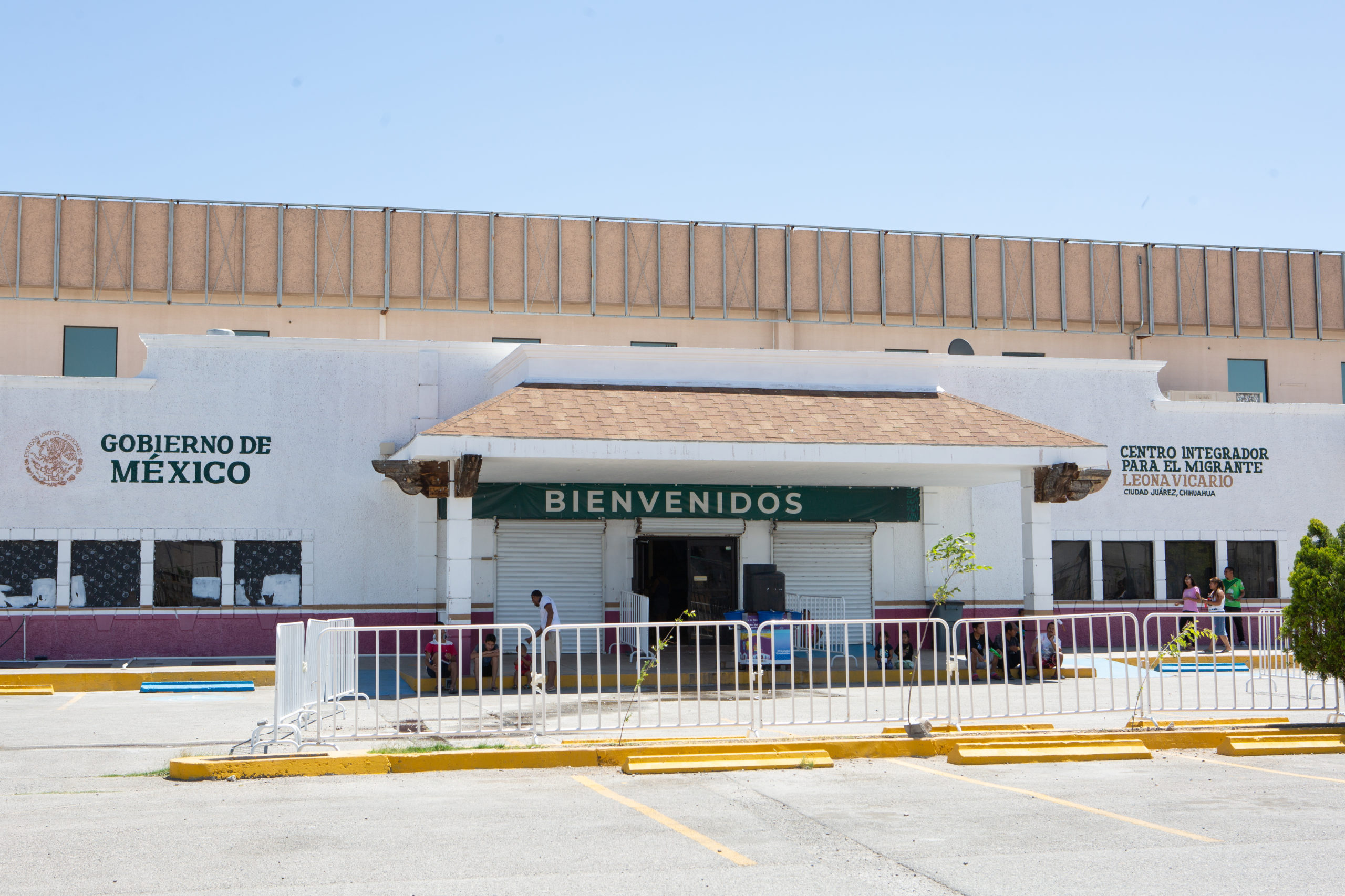
They tried to cross anyway in September, but were immediately caught and returned. Afterward, they struggled to find jobs and a safe place to stay. Two U.S. immigration court dates passed without any progress—one in October and one in December. A U.S. judge, addressing her via an international video link, told her to get a lawyer, but she couldn’t afford the fees.
The couple skipped their usual Christmas celebrations. That same month she was assaulted, and her purse was stolen with all of her court documents inside. Then, at the end of February, came a rare spark of joy. After missing her period two months in a row, she took a pregnancy test. It was positive. Back in Cuba, they had been trying for a baby, but their plans had been sidelined. “The news made us both happy and sad at the same time,” she remembers.
Her husband’s family in the U.S. began receiving mysterious phone calls about whether they knew anyone in Mexico. On February 28, while walking to work, D.T. sensed someone following her. The man chased her, so she ran, but he overpowered her and began dragging her toward an abandoned house. She fought back, scratching, hitting, and kicking and managed to escape. But in the struggle, she was struck in the stomach.
She called her husband and they decided to go to the police and file a report. But Mexican officials told her there was nothing else they could do. She believes the attack was related to those anonymous calls.
After leaving the prosecutor’s office, D.T. began getting texts from other migrants saying that a U.S. federal judge had declared Remain in Mexico to be a violation of international and federal law. She headed to the bridge and was one of the first in a crowd of about 300 migrants to arrive. “I was desperate,” she said. “I didn’t want to be here in Mexico anymore and was hoping that the [program] would be annulled and they would let us through.”
D.T. pleaded with U.S. immigration officials for an interview. Despite fresh welts on her face and police report in her hand, they turned her away.
Months later, she’s still waiting in fear along with many other asylum-seekers. But as a physician, she realized there were ways that she could help.
Matamoros: A Tent Hospital in Tamaulipas
An enormous tent city of more than 2,000 stranded migrants has risen along the banks of the Rio Grande River in Matamoros, another strife-torn border city in Tamaulipas just south of Brownsville, Texas. Just to the side of the Gateway International Bridge at the U.S. port of entry, a chain-link fence guarded by Mexican authorities armed with thermometers marks the start of hundreds of small, colorful tents filled with asylum-seekers and other would-be U.S. immigrants. The tents sit side by side, almost always less than 6 feet apart. One tent, apart from the others, is reserved for those in quarantine after exposure to the virus.
Two huge empty tents contain specialized medical equipment and supplies, including medications from the local pharmacy, personal protective equipment, X-ray machines, heart monitors, and oxygen concentrators. Andrea Leiner, a nurse practitioner and strategy coordinator with medical aid nonprofit Global Response Management (GRM), worked with the GRM team for months to get that tent hospital in place.
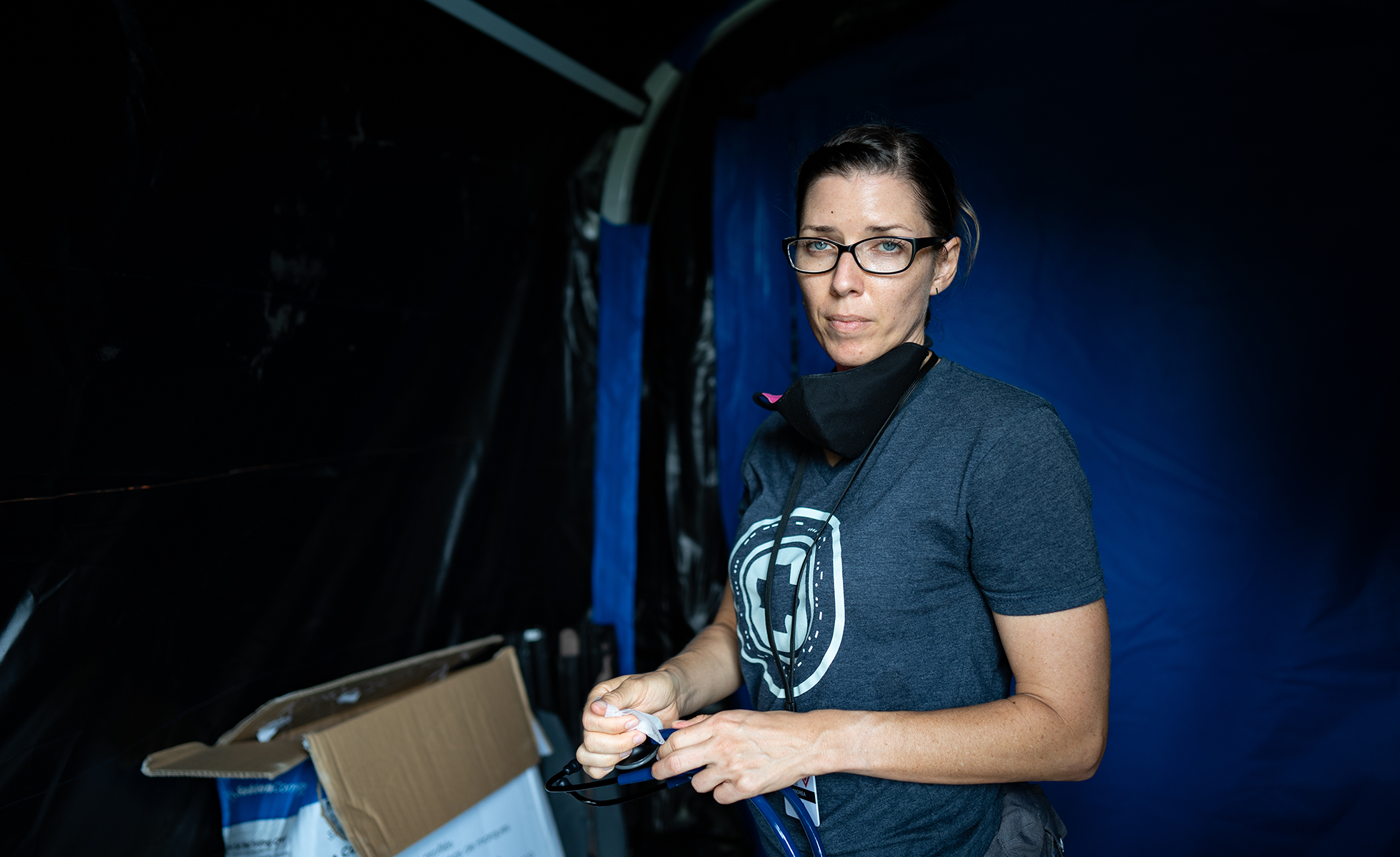
Leiner, a Floridian and daughter of a fire chief, grew up confident that her calling was in helping the vulnerable. With a lifelong interest in medicine and in volunteering, she did not hesitate when she heard about GRM’s work via a podcast. Her first assignment in December was this sprawling camp.
People first began pooling together here after MPP, or Remain in Mexico, was put in place in 2019. The camp has exponentially grown in population—and in creative use of local and nonprofit resources—since then.
In October, the first team of six GRM volunteers arrived and began treating patients out of their backpacks on the sidewalk. A week later they set up on a $49 table from Walmart. By the time Leiner arrived in December for the first of many rotations, a mobile medical unit had been set up inside a couple of campers with basic medical equipment and makeshift examination rooms. Outside, folding chairs made up a waiting room, where volunteers checked in patients. The clinic was staffed both by U.S. volunteers and by refugee medical experts who also were stuck alongside others waiting in MPP.
Leiner still remembers how she paused in awe at her first view of the camp when she crossed the international bridge on foot. The mother of a 7-year-old, Leiner said she immediately focused on the plight of children and parents stuck at the camp and struggling to survive.
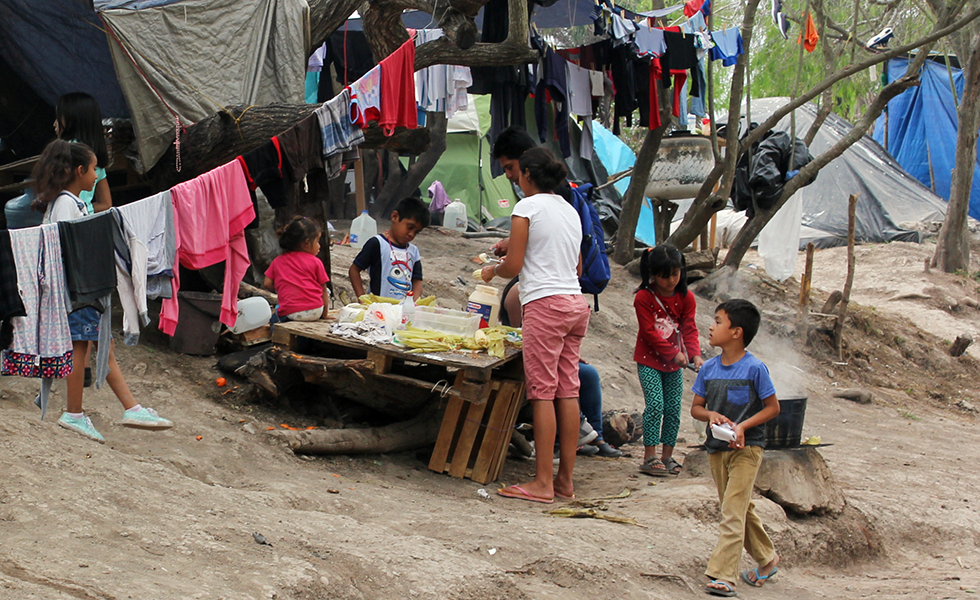
On her first work day, two little girls, both about her daughter’s age, approached and volunteered to assist her. Leiner asked the girls why they had come. They told her their cousins had been murdered with a machete and their parents were waiting to present evidence to U.S. authorities in hopes of being granted asylum.“Do you want to see pictures?” one girl asked. Speechless at the girls’ resilience and their altered sense of the normal, Leiner accepted their help.
For her first few months, Leiner rotated into Matamoros every three weeks to provide medical services for a few days before returning to her home hospital in Naples, Florida. But as COVID-19 cases increased, so did her time in the camp. As the U.S. and Mexico issued warnings in February for their own residents, Leiner and her team realized it would be up to nonprofits to care for migrants abandoned by both governments. “The people on the margins are going to be most vulnerable,” Leiner said.
By March, about 2,600 people resided in the makeshift settlement, according to a census by volunteers. Leiner’s team began planning for what seemed like an inevitable outbreak. As other aid organizations stocked up on food and cleaning supplies, local officials told GRM that Matamoros had only 10 respirators in its hospitals and emergency rooms in the area would admit only life-threatening emergencies. GRM proposed to erect a tent hospital with an estimated cost of $500,000.
With partner organizations like Team Brownsville, Angry Tias and Abuelas of the Rio Grande Valley, and private donors, fundraising was swift. But with nationwide shortages, GRM and their partner organizations raced to find and purchase medical equipment, tirelessly putting in inquiries with contacts and searching the internet. Then a bigger struggle began—a game of political ping pong with U.S. and Mexican customs offices to receive permits and permissions necessary to transport the equipment from the U.S. into the tents. For weeks, as one permission was approved, another issue arose.
Finally, on the sunny Friday morning of April 24, Leiner stood with colleagues at the customs offices at the port of entry, with all the signed permissions in hand and the equipment packed. Patiently, they waited a few hours more as each document was processed.
As hope was once again beginning to slip, Leiner spotted the first truckload crossing the border and a proud smile spread across her face. Her team—made up of medical professionals, volunteer migrants, and visiting volunteers—rejoiced. Then, the community began to assemble their field hospital. Some learned on the job. Others, out-of-work migrant builders, electricians, and construction experts, took the opportunity to put their skills into practice. “Getting the field hospital up was a labor of love,” Leiner said. “It makes all of those days working in the sun and the mental and political gymnastics to make this happen all worth it.”
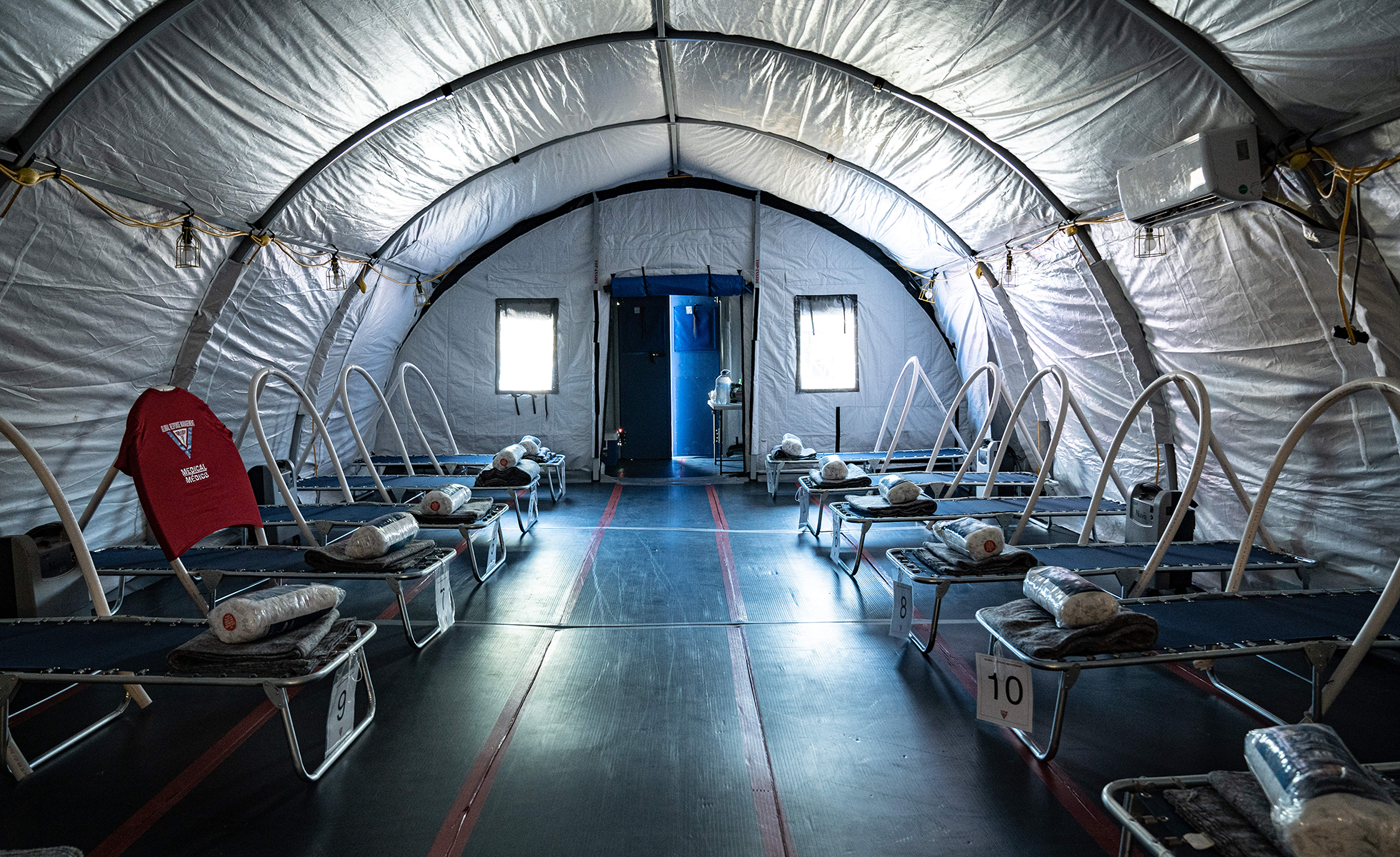
In the camp, some migrants worry even with the tent hospital so close at hand. One Honduran woman and her child were among those who spent time confined to the quarantine tent, separated from the others for fear that they had been exposed. Luckily, they later tested negative.
Another resident, 61-year-old Diana Josefina Roman de Vasquez from Venezuela, arrived in the camp six months ago after being held by a “coyote” in a bodega. She began seeking asylum after being released by her captors but was sent back to wait in Mexico after briefly being taken into CBP custody. She fears that if she gets sick she might not survive: In Venezuela she was diagnosed with a lung condition. With half of her left lung not working and her daughter unable to send money after losing a job due to the pandemic, Roman de Vasquez lives month to month, relying on donations for the medications she needs to survive. She sleeps sitting up in her tent to prevent choking during the night.
Roman de Vasquez’s condition prevents her from being able to work, so she hardly leaves the camp and walks around with a facemask as a preventative measure. Every night, she prays that God will grant her the miracle of hugging her grandchild, who was born and lives with her daughter in the U.S. “I cry every night but I will never abandon my dream,” Roman de Vasquez said. “I want to die in the U.S. so I can die with my daughter.”
So far she and the other migrants here have been lucky. As of June, the 80 antibody tests and seven COVID-19 tests administered to camp residents had all come back negative. GRM confirmed its very first case at the camp this week.
Leiner recently finished her most recent stint in the camp. The field hospital tent still sat empty in early June—their efforts to screen and quarantine appear to have kept the virus out for now. But GRM volunteers are now looking around them and along the border to see who else can benefit from their resources. They’re sharing information with affected shelters and camps in other U.S.-Mexico border cities like Juárez and Reynosa, and also with communities near the Mexico-Guatemala border. The possibility of opening similar field hospitals at any or all of these locations persists as migrants remain stuck and U.S. deportees continue to arrive.
Ciudad Juárez: Fear of the Virus Spreads
After her release from U.S. custody, D.T. and her husband struggled. Mexico ordered a nationwide lockdown that closed non-essential businesses. Both lost their jobs. Around the same time, D.T. passed a large blood clot. She didn’t go to the doctor—it was too expensive—but she knew what happened. An at-home pregnancy test two weeks later confirmed her suspicion. It was negative. She had lost the baby. “Losing it like that and being so afraid that I couldn’t even go to a doctor for a check-up was very hard for me,” she said.
After six weeks without work, the couple couldn’t pay rent. “We had no food to eat and no one to help us,” she said. In desperation, D.T. turned to a local church. She felt grateful for the help of strangers and decided to find ways to help other vulnerable migrants herself. She started a WhatsApp group called Help for Immigrants to connect families with “good Samaritans” who donate food.
Word spread. In Juárez, more than 50 migrant families signed up. In El Paso, donations came from pastors, NGOs, and a Cuban-Panamanian family. Members of the group started asking for medical advice when they learned she was a doctor. She was happy to help, in part because immersing herself in work helped her deal with the trauma of her miscarriage.
“How have you been feeling?” she asks her migrant patients who often text her in desperation. They describe symptoms—often fevers, coughs, or aches—and she tries to diagnose them as best she can without a physical examination. For serious problems, like breathing difficulty, she advises going to the hospital. WhatsApp consultations aren’t as effective as an in-person diagnosis, but she is doing what she can. “That is how I try to do my part to help my community,” she said. “Because I feel identified as a migrant too.”
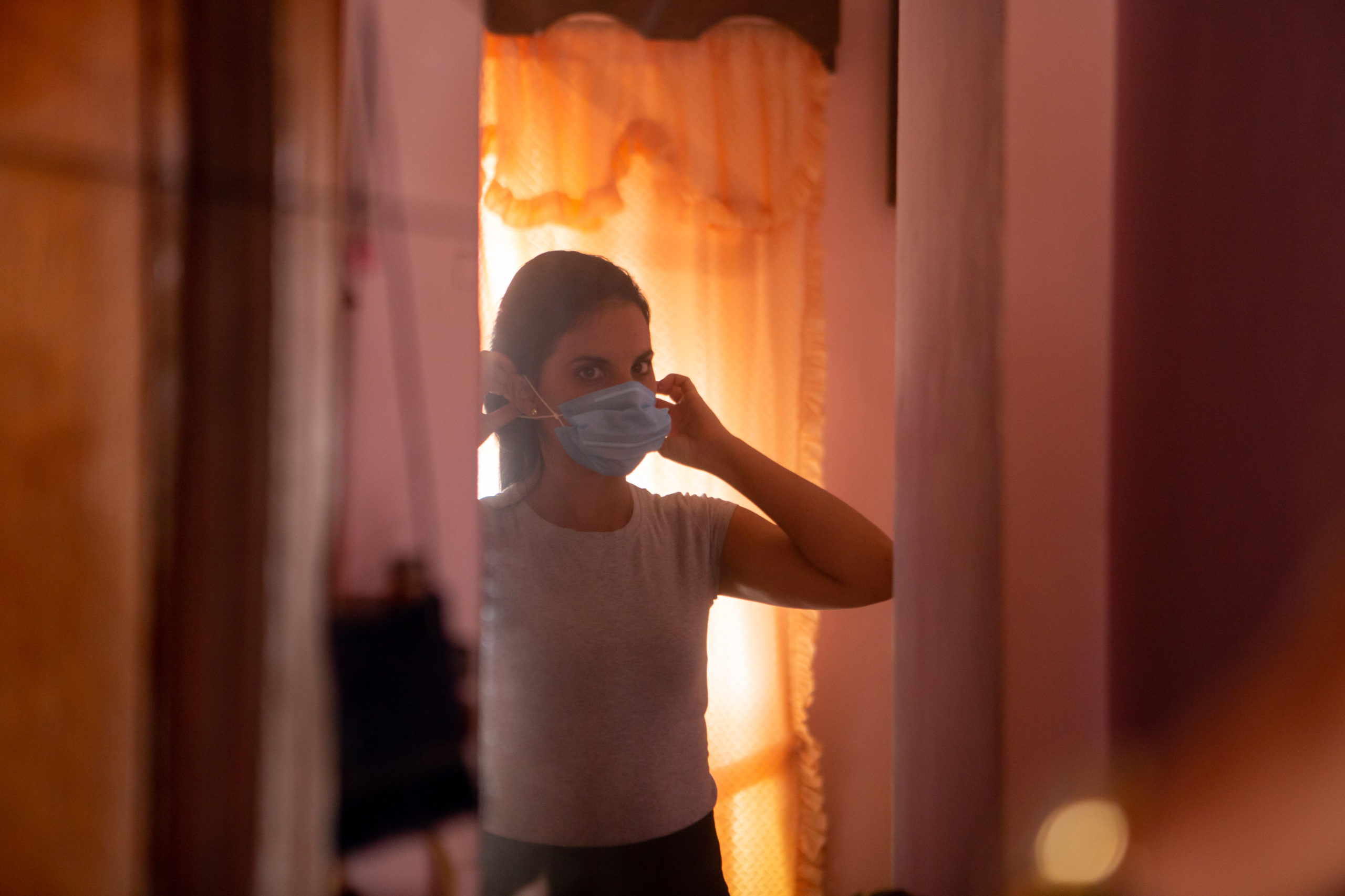
But as a volunteer, she wasn’t getting paid. After a long search, she finally found a position as a medical assistant at a clinic under the supervision of a Mexican doctor, since she has no license to practice in Mexico. “With this, at least I can work,” she said. “I can support myself while I am going through this difficult situation.”
But D.T. knows being in direct contact with sick patients is risky and could expose her to COVID-19 too. One day in May, an elderly woman came in with respiratory symptoms. Most of the estimated 15 patients she sees each day have similar flu-like symptoms, normally uncommon this time of year. Her work doesn’t provide any protective equipment, but D.T. buys her own masks. This particular patient had underlying health issues and little money. A few days later, she learned that the patient tested positive for the coronavirus. “I am sure a lot of those respiratory symptoms are from coronavirus,” she said. “I am in direct contact with these people and I have to do it because I have to work. Because I have to eat.”
As of early June, more than 1,300 people in Juárez had been diagnosed with COVID-19. The International Rescue Committee confirmed an outbreak at a government-run shelter where IRC provides aid. But testing is limited in Juárez, making it difficult to weigh the risks. “We do not have access to any kind of diagnosis that can tell us whether we are sick or not,” D.T. said. “So, we keep transmitting the disease among ourselves.” Just across the border, El Paso County, Texas has about three times as many reported cases.
She already had a long list of worries, and the coronavirus is just one more. She still fears being attacked on her way to work. Her husband recently started receiving threats on WhatsApp. She’s still coming to terms with the traumatic way her pregnancy ended. D.T. would have been well into her second trimester by now. Instead, she has lost weight on her already thin frame, and her hair is falling out from stress. “I still do not sleep well. My sleep is very difficult, and I block the door of my house because I am afraid that people will come in,” she said. “When I go out, I’m very afraid, but I have to work.”
The risk of contracting the coronavirus looms, but she keeps busy by working full time, organizing food deliveries, and doing night-time medical consultations. Things might be different if she knew that a life in the U.S. were within reach, or if she had something to look forward to, like the birth of her first child. But one delay always seems to lead to another. Her next court date was postponed to July and then again until August, as the date when immigration courts are scheduled to reopen for MPP cases continues to be pushed back. She has already heard that other migrants’ court dates are being rescheduled for 2021.
“It’s a horrible feeling,” she said. “It’s a feeling of instability, of uncertainty, of constant fear.”
Editor’s note: This story has been edited to mask the identity of doctor D.T., the Cuban asylum-seeker, at the request of an attorney who expressed concerns about her safety.
Anna-Catherine Brigida is a freelance journalist based in Nicaragua who has reported on migration from the region since 2015. She has covered migrant caravans, deportations, migrant deaths, and family separations for media outlets such as the Washington Post, the Guardian, TIME, Texas Monthly, and Al Jazeera. In 2019, she reported on the deaths of Guatemalan minors at the U.S. border as part of the Reporting the Border Fellowship through the International Center for Journalists and the Border Center for Journalists and Bloggers.
Emily Kinskey is a freelance multimedia journalist based in El Paso, Texas. She produces cinematic documentary films that offer an intimate character-driven approach. Her TIME magazine film, Welcome to America, about zero-tolerance policy in the United States, won a Webby in 2018. She produces films and photo stories for outlets including TIME, NBC, CNN, the Texas Tribune, and nonprofit organizations.
Acacia Coronado is a reporter for the Associated Press. As a fellow for the Texas Observer in 2020, she covered immigration and deportation issues and broke new ground on conditions in the largest migrant camp on the Texas-Mexico border.
Read more from the Observer:
As COVID-19 Cases Surge, Some Incarcerated People Remain Behind Bars After Making Bail: Electronic monitoring companies refuse to touch coronavirus-positive inmates. That means they can’t go home.
Young Texans Keep Spelling Bees Going From Home: When the Scripps National Spelling Bee was canceled in March, two former competitors from The Woodlands stepped up to organize a virtual bee. Now, other bees are following suit.
Texas Landlords Are Filing Hundreds of Illegal Evictions: As courts reopen in Harris County, tenants may be removed from their homes as COVID-19 cases skyrocket, despite CARES Act protections that guarantee shelter.

